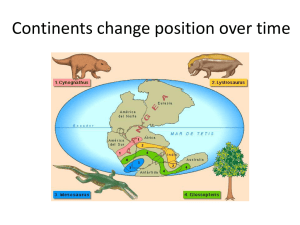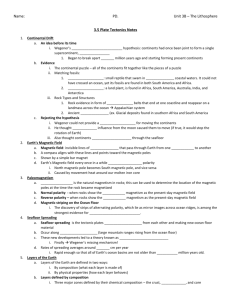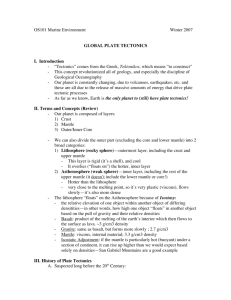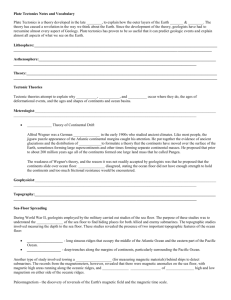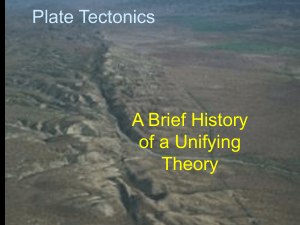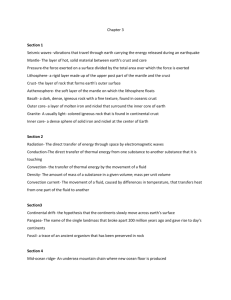E Topic 4 notes - The University of West Georgia
advertisement
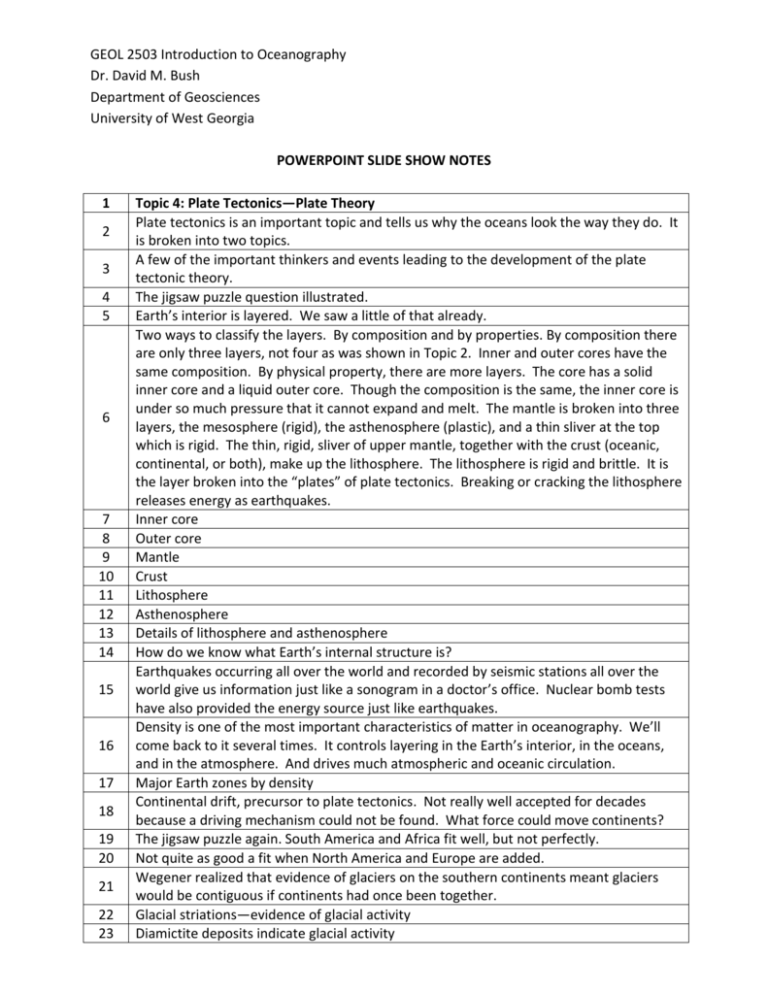
GEOL 2503 Introduction to Oceanography Dr. David M. Bush Department of Geosciences University of West Georgia POWERPOINT SLIDE SHOW NOTES 1 2 3 4 5 6 7 8 9 10 11 12 13 14 15 16 17 18 19 20 21 22 23 Topic 4: Plate Tectonics—Plate Theory Plate tectonics is an important topic and tells us why the oceans look the way they do. It is broken into two topics. A few of the important thinkers and events leading to the development of the plate tectonic theory. The jigsaw puzzle question illustrated. Earth’s interior is layered. We saw a little of that already. Two ways to classify the layers. By composition and by properties. By composition there are only three layers, not four as was shown in Topic 2. Inner and outer cores have the same composition. By physical property, there are more layers. The core has a solid inner core and a liquid outer core. Though the composition is the same, the inner core is under so much pressure that it cannot expand and melt. The mantle is broken into three layers, the mesosphere (rigid), the asthenosphere (plastic), and a thin sliver at the top which is rigid. The thin, rigid, sliver of upper mantle, together with the crust (oceanic, continental, or both), make up the lithosphere. The lithosphere is rigid and brittle. It is the layer broken into the “plates” of plate tectonics. Breaking or cracking the lithosphere releases energy as earthquakes. Inner core Outer core Mantle Crust Lithosphere Asthenosphere Details of lithosphere and asthenosphere How do we know what Earth’s internal structure is? Earthquakes occurring all over the world and recorded by seismic stations all over the world give us information just like a sonogram in a doctor’s office. Nuclear bomb tests have also provided the energy source just like earthquakes. Density is one of the most important characteristics of matter in oceanography. We’ll come back to it several times. It controls layering in the Earth’s interior, in the oceans, and in the atmosphere. And drives much atmospheric and oceanic circulation. Major Earth zones by density Continental drift, precursor to plate tectonics. Not really well accepted for decades because a driving mechanism could not be found. What force could move continents? The jigsaw puzzle again. South America and Africa fit well, but not perfectly. Not quite as good a fit when North America and Europe are added. Wegener realized that evidence of glaciers on the southern continents meant glaciers would be contiguous if continents had once been together. Glacial striations—evidence of glacial activity Diamictite deposits indicate glacial activity 24 25 26 27 28 29 30 31 32 33 34 35 36 37 38 39 40 41 42 Diamictite Fauna refers to all the plants and animals in an area. The Glossopteris fauna is an assemblage of specific plant and animal fossils. Fossil distribution indicates continents were assembled at one time. Pangaea is the name Wegener gave to the supercontinent that existed 250 million years ago (myBP means million years before present). Also spelled Pangaea. The word means “all earth.” Likewise, if the land is all assembled into a single continent, that must leave Earth with a single ocean—Panthalassa, or “all sea.” As Pangaea broke apart and continents moved, Panthalassa has been divided into the oceans we have today. Continental arrangement today versus 200 million years ago. Sea floor spreading. The force that drives continental movement and ocean changes. Much of the evidence was obtained thanks to oceanic observations during World War II, and by major research spending after the war. Sea floor spreading. Rising up of molten rock to form new sea floor at mid-ocean ridges, and sinking and recycling of old sea floor at subduction zones (trenches). Convection is driven by differences in density. Sea floor spreading explains many observed phenomena. Note that seismic events (earthquakes) are mainly restricted to narrow belts. Same with volcanoes Age of sea floor increases with distance away from mid ocean ridges (spreading centers). Sea floor spreading moves ocean floor (oceanic crust) away from where it formed. There is also a magnetic signal recorded in the rocks. All rocks of the same age have the same magnetic polarity. Iceland is on the mid-ocean ridge Paleomagnetism. Earth’s magnetic field reverses relatively often compared to the rate of creation of new ocean crust. The reversals are recorded in the rocks. As molten rock cools, Earth’s magnetic field direction is recorded in magnetic minerals in the rock. We also see this record on land in stacked lava flows. As sea floor spreading progresses, magnetic reversals are recorded as “magnetic stripes” in the oceanic crust. The very uniform and predictable oceanic crust age and magnetic polarity relationship made it obvious that the sea floor is spreading away from mid-ocean ridges, the spreading centers. Paleomagnetic patterns. The age/polarity relationship and magnetic stripes. Magnetic striping in the Pacific Ocean off northwestern USA and southwestern Canada. The Juan de Fuca and Gorda Ridges are spreading centers. Note that the stripes east and west of the ridges are mirror images.


